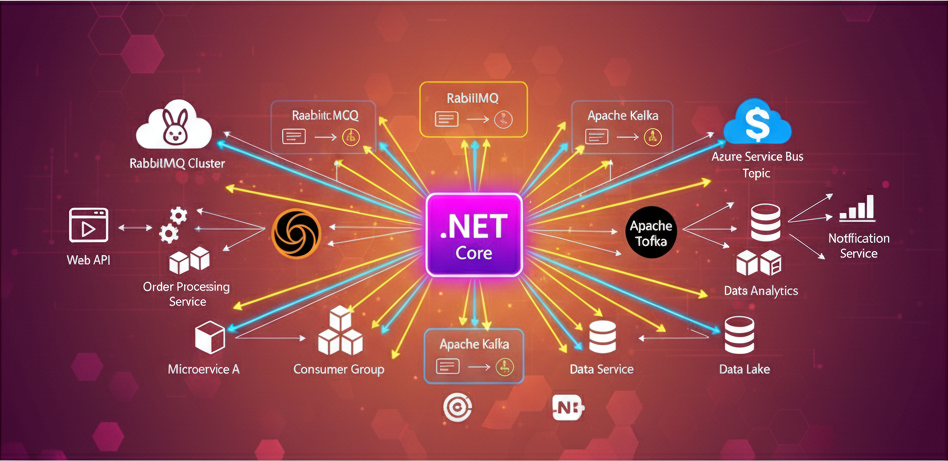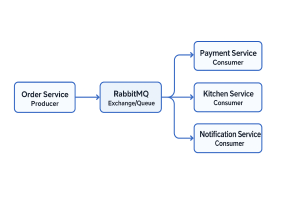Message Brokers in .NET Applications: RabbitMQ, Azure Service Bus, and Kafka

In modern distributed systems, effective communication between services is critical for maintaining scalability, resilience, and flexibility. At PIT Solutions, we leverage message brokers in .NET applications to build scalable, resilient, and fault-tolerant systems. Instead of relying on synchronous API calls (such as REST or gRPC) that tightly couple services—leading to cascading failures, latency bottlenecks, and reduced fault tolerance—many applications now adopt message brokers to enable asynchronous, reliable, and scalable communication
Benefits of Using Message Brokers in .NET Applications
Decoupling Services
- Producers (senders) and consumers (receivers) interact via a broker rather than directly, reducing dependencies.
- Services can evolve independently without breaking contracts.
Asynchronous Processing
- Messages are queued, allowing services to process them at their own pace.
- Eliminates blocking calls, improving system responsiveness.
Improved Fault Tolerance
- If a consumer fails, messages remain in the queue for later processing.
- Retries and dead-letter queues (DLQs) handle failed messages gracefully.
Scalability & Load Leveling
- Brokers buffer traffic spikes, preventing service overload.
- Consumers can scale horizontally to process messages in parallel.
Event-Driven Architectures
- Supports pub/sub models (e.g., Kafka, RabbitMQ) where multiple services react to events in real-time.
- Enables event sourcing, CQRS, and real-time analytics.
RabbitMQ in .NET Applications – Features & Use Cases
RabbitMQ is best suited for lightweight, flexible messaging with low latency. It offers:
- Support for multiple protocols like AMQP, MQTT, and STOMP.
- Powerful routing through queues and exchanges (direct, fanout, and topic-based).
- Reliable delivery with at-least-once and exactly-once semantics via acknowledgments.
- Easy deployment and management.
Real-World Examples
Taxi Booking (Early Architecture) – Task Queues: Used to manage background jobs such as sending ride notifications and processing payments, decoupling microservices and ensuring reliable message delivery between booking, payments, and notifications.
Food Delivery – Order Processing: Decouples order placement from downstream services like kitchen assignment and delivery dispatch, ensuring no orders are lost even during peak times.
Inventory Management in Retail: Synchronizes inventory updates between warehouses and online storefronts, preventing overselling and keeping stock levels accurate across channels.
Azure Service Bus for Enterprise .NET Messaging
Azure Service Bus is ideal for enterprise-grade messaging within Microsoft and Azure ecosystems. It offers:
- Fully managed service with no infrastructure overhead.
- Support for queues and topics with advanced pub/sub filtering.
- Reliable delivery through at-least-once and exactly-once guarantees via sessions.
- Built-in geo-replication and disaster recovery for high availability.
Real-World Examples
Shipping & Logistics – Global Shipment Tracking: Tracks shipments across regions with reliable message queues, ensuring updates are never lost, even during network failures.
Flight Operations – Booking Management: Manages real-time booking updates across multiple systems, ensuring reliability during peak booking periods.
Bank Transaction Processing – Secure Messaging: Provides secure, reliable messaging between core banking systems during high-volume transactions to prevent duplicates and losses.
Order Fulfillment & Notifications – Sales Event Scaling: Synchronizes inventory and sends order updates during high-traffic sales events, preventing overselling.
Apache Kafka for High-Throughput .NET Event Streaming
Apache Kafka is best suited for high-throughput event streaming and real-time analytics. It features:
- Distributed, persistent, and fault-tolerant log storage.
- Combination of pub/sub and queuing through consumer groups.
- Ability to handle millions of messages per second.
- Built-in stream processing with Kafka Streams and ksqlDB.
Real-World Examples
Netflix: Streams real-time user activity (clicks, views, watch history) to power personalized recommendations, handling over a trillion events daily.
LinkedIn: Powers real-time activity feeds for posts, likes, comments, and shares, ensuring instant updates for millions of users.
Zomato: Streams real-time order events (food prepared, rider assigned, out for delivery) to enable live tracking for customers and restaurants.
Paytm: Processes billions of transactions in real-time for fraud detection, streaming data to ML models for instant suspicious activity blocking.
IoT Telemetry in .NET : A fleet of IoT devices sends telemetry (temperature, GPS, usage data) into Kafka. A .NET Core consumer app processes the stream and pushes insights into Azure Data Lake for analytics and dashboards in Power BI.
E-commerce Order Tracking with .NET & Kafka : A .NET microservices system publishes order events (OrderPlaced, PaymentConfirmed, Shipped) to Kafka. Consumers update different services in real-time (inventory, notifications, fraud detection).
How Message Brokers Work in .NET Microservices
A message broker acts as middleware between applications or services.
It receives messages from a producer, stores them temporarily, and delivers them to one or more consumers.
Basic Flow:
- Producer – Sends a message to the broker instead of calling the consumer directly.
- Broker – Stores the message in a queue or topic until it is processed.
- Consumer – Retrieves (or is pushed) the message from the broker and processes it.
Example: Food Delivery Application with RabbitMQ
In a food delivery application, when a customer places an order, the system needs to confirm the order immediately, assign it to a kitchen, dispatch a rider, and send real-time updates to the user. Using a message broker like RabbitMQ allows each of these steps to happen asynchronously, so services can work independently without waiting for each other to complete.
Step-by-Step Flow:
- Order Service (Producer)
- Places the order in the database.
- Sends a message “OrderPlaced” to the Order Queue in RabbitMQ.
- RabbitMQ (Broker)
- Stores the “OrderPlaced” message.
- Makes it available to any subscribed consumers.
- Kitchen Service (Consumer)
- Listens to the Order Queue.
- Receives the “OrderPlaced” message.
- Prepares the meal and sends “OrderReady” to another queue.
- Delivery Service (Consumer)
- Listens to the “OrderReady” queue.
- Assigns a rider and sends “OutForDelivery” to a Notification Queue.
- Notification Service (Consumer)
- Sends push notifications to the customer based on events.
Advantages:
If the kitchen service is temporarily unavailable, the “OrderPlaced” message remains in the queue until it can be processed. During peak hours, RabbitMQ buffers incoming messages to prevent service overload. Additionally, each service can be scaled independently, such as adding more kitchen service instances during busy meal times, without affecting the others.
Architecture Patterns Using Brokers in .NET Applications
In .NET applications, message brokers are more than just middleware, they influence how systems are architected and how services communicate. One common approach is event-driven microservices, where instead of making direct HTTP calls, services publish events to a broker like RabbitMQ or Azure Service Bus. For example, an OrderService in ASP.NET Core might publish an “OrderPlaced” event, which is then consumed by services such as PaymentService and NotificationService without either being tightly coupled to the order service. This improves scalability, fault tolerance, and makes it easy to add new subscribers without modifying the producer.
Another pattern is CQRS (Command Query Responsibility Segregation) combined with event sourcing. In this model, .NET applications separate read and write operations into different models and store all changes as events. A Command API might publish a “UserRegistered” event to Kafka, while a separate Query API listens for the event, updates a read-optimized store, and serves queries. This provides a complete audit trail, allows rebuilding system state by replaying events, and supports scaling for read-heavy scenarios.
Brokers also support asynchronous task processing, which is useful when a web application needs to handle time-consuming tasks without delaying responses. In .NET, the API can publish a message to a broker and return immediately to the client, while a background worker service (using IHostedService) processes the message in the background. For example, when a file is uploaded, the API might publish an “ImageUploaded” message to Azure Service Bus, which a worker later picks up for processing.
Real-time notifications: Another pattern enabled by brokers. When a cmessage such as “NewMessageReceived” is published to RabbitMQ, a .NET service can consume it and use SignalR to broadcast the update to connected clients instantly, delivering a live user experience without polling.
Finally, brokers are central to data pipeline and integration patterns in .NET applications. IoT devices, for example, can stream telemetry data to Kafka, where a .NET Core consumer processes and stores it in Azure Data Lake or SQL Server for analytics. This decouples data ingestion from processing and allows handling massive streams of incoming data efficiently.
Future of Message Brokers in .NET with AI
In the .NET ecosystem, message brokers are evolving from simple message carriers to smart, decision-making tools with the help of artificial intelligence. AI can help brokers decide which messages are most important and where they should go. For example, payment confirmations can be sent right away, while less urgent messages can wait. Using ML.NET or Azure Machine Learning, brokers can make these decisions automatically. AI can also predict when traffic will increase and scale up .NET consumers in Azure Kubernetes Service or Azure Container Apps before the system gets overloaded.
AI will also make brokers better at spotting problems and adding extra information to messages. They can learn what normal traffic looks like and quickly detect failures or unusual patterns, then take action to fix them. With Azure Cognitive Services or ML.NET, brokers can add details like sentiment scores or fraud check results to messages before sending them on. This means brokers in applications will not just deliver messages they will also improve the speed, safety, and quality of communication across the system.
Conclusion
Message brokers are a cornerstone of modern distributed systems, enabling decoupled, resilient, and scalable architectures. They not only enhance performance but also open doors to advanced patterns like event sourcing, CQRS, and real-time analytics. With our expertise at PIT Solutions, we implement RabbitMQ, Azure Service Bus, and Kafka in .NET projects to improve performance, scalability, and reliability, helping businesses build future-ready applications.













